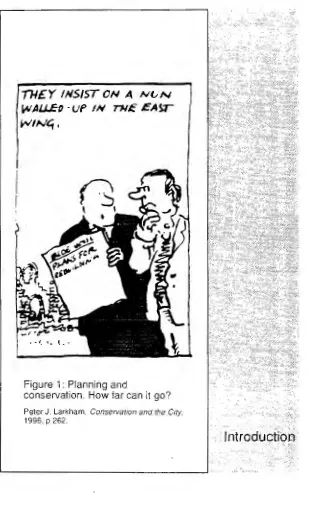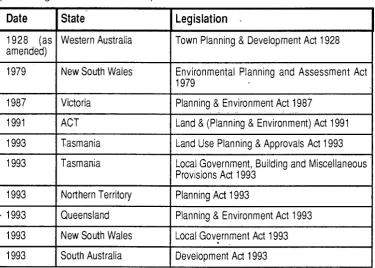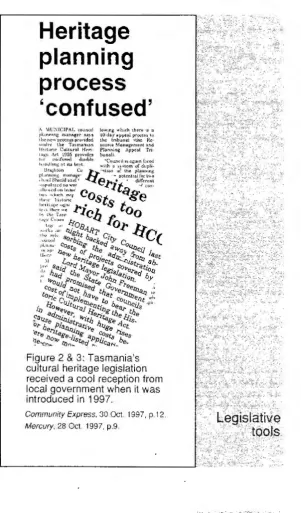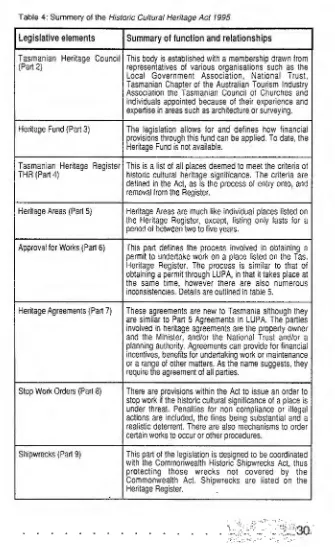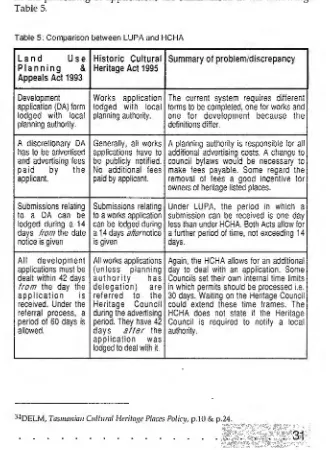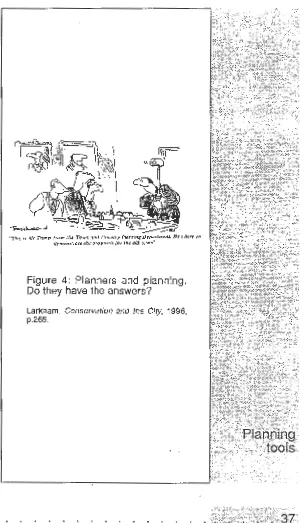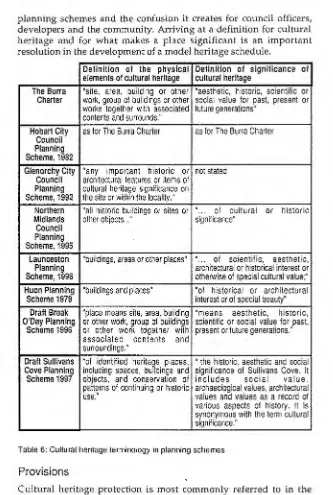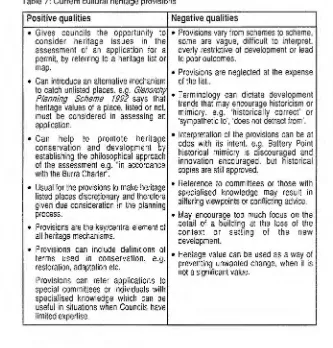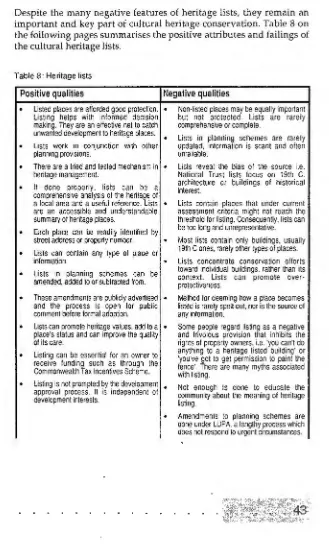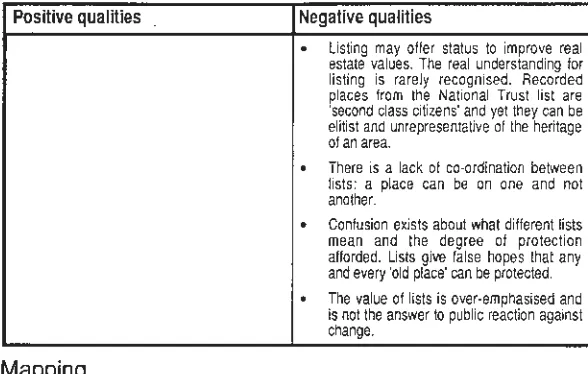Cultural heritage
planning:
A new perspective
By Sarah Waight B.Sc. (Arch), Dip. Mus. Stud.
Submitted in partial fulfilment of the requirements for the degree of Master of Town Planning
University of Tasmania
Declaration
The material in this project is original except where due acknowledgement is given and has not been accepted for the award of any other degree or diploma.
~a:0'~/--...
~C.~7::..... /
...
...
..
Acknowledgment
Sincere thanks are extended to the many people who have supported me in the preparation of this report. I would especially like to thank Stephen Waight for his ongoing encouragement and discerning observations and Barbara and Stan Payne for their astute comments. Thanks are also extended to Damien Ylugavin, and the staff of Glenorchy City Council and Hobart City Council.
Authority of Access
Table
of Contents
List of tables ... 3
List of illustrations ... 3
Acronyms ... 3
Chapter 1: Introduction ... 4
Introduction ... 5
Background ... 5
Objective ... 6
Approach ... 8
Chapter 2: Agents of change ... 10
Introduction ... 11
Conservation and change ... 11
An historical overview ...................... 11
Current COilServntion practice ill the UK ...... 13
Australian conservation legislation ... 14
A11 historical overview ................... 14 State heritage conservation and planning legislation ... 16 Victoria ......... 18
New South Wnles ... 18
South Austrnlin ..... 19
Westem Austrnlin ... 19
Northem Territory ................ 19
Queenslnud ......... 20
ACT ... 20 Tnsmnl!ia ............ 20
The Burra Charter ... 21 Conclusions ... 22 Chapter 3: Legislative tools ... 24
Introduction ... 25
Land use planning and cultural heritage ... 25
State of cultural heritage ... 27
Tasmania's cultural heritage legislation ... 28
Background .......................... 28
Outline of legislative frnmework ... 29
Conclusions ... 36
Chapter 4: Planning tools ... 37
Introduction ... 38
Planning mechanisms for cultural heritage ... 38
Definitiolls ...... 38
Provision:> ........... : ..... 39 Lists, registers n11d schedules ....... ~/
Case studies ... 45
llltroductivll ..................................... 45
WhtJ Nt."tt' Tow11 Rivulet? ........................ 45
Cas~ Study J: 'Warwick Lodge', Albert Road, Moo1wh ........ 41
Case Study 2: Pitt Farm, Albert Road, Moo11ah ... 48
Case Study 3: New Taw11 Bridge, Maill Road ................ 50
Case Study 4: Stai11jarth Cove, New Toum Bay ............... 52 Case Study 5: New Taw11 Park, Tower Rand, New Tow11 ... 53
Case Study 6: Migrn11t workers houses ...... 54
Conclusions ... 55
Chapter 5: A new technique ... 57
Introduction ... 58
Towards model cultural heritage provisions ... 58
The 1992 Model Ordilla/lce ........ 58
DELM drnftgrtidcfilles aHd provisio11s ... ....... , ... 59
Model pfnll/ling sche111e resurfaces ........................ 61
Draft Sullivans Cove Planning Scheme 1997 ... 62
Descriptio11 ... 62
Clause 22.4 ...... 63
Clause 22.5 ... 63
Clause 22.6 ...... 64
StreHgths & weak11esses ..... 65
Draft Break O'Day Planning Scheme 1996 ... 65
Descriptio11 ... 65
Stre11gths & wenk11esses ... 67
Cone! usions ... 68
Chapter 6: A new perspective ... 69
Introduction ... 70
Legislative tools ... 70
Cmeml directio11s .............................. 70
Ame11dmellfS .............................. 72
Planning tools ... 75
Discussiv11 ...... 75
Part X Model cult urn/ heritage schedule ....... 77
Future ... 82
List of
tables
Table 1: Recent & current State heritage legislation ... 17
Table 2: Current State and Territory planning legislation ... 17
Table 3: Cultural heritage terminology ... 27
Table 4: Summary of the Historic Cultural Heritage Act 1995 .... 30
Table 5: Comparison between LUP A and HCHA ... 31 Table 6: Cultural heritage terminology in planning schemes ... 39
Table 7: Current cultural heritage provisions ... 42
Table 8: Heritage lists ... 43
Table 9: Mapping ... 44
List of illustrations
Cover Page: City of Hobart Pla11ning Scheme 1982, p. 77. Hobart Atlas, 1969, p.21-22. Figure 1: Planning and conservation ... 4Figure 2 & 3: Publicity for the new cultural heritage legislation ... 24
Figure 4: Planners and planning ... 37
Figure 5: New Town Rivulet ... 46
Figure 6: Warwick Lodge... .. ... 47
Figure 7: Land grant map of Stainforth Cove ... 48
Figure 8: Pitt Farm ... 49
Figure 9: Sale advertisement for Pitt Farm ... 49
Figure 10: 19th century view of Iew Town Bridge ... 50
Figure 11: New Town Bridge in April1997 ... 50
Figure 12: New Town Bridge in June 1988 ... 51
Figure 13: 1954 map of land reclamation in New Town Bay ... 52
Figure 14: New Town Park in the 1890s ... 53
Figure 15: NewTown Park in 1998 ... 53
Figure 16: Wilmslow Avenue in 1954 ... 54
Acronyms
DELMHCHA LUPA RMPS RPDC THR
Department of Environment and Land Management
IH£Y
INSIST ON A N~NWAJ.J.£-D
·U
P
IN rH£ EAW ~IN<:f,Figure 1: Planning and
conservation. How far can it go?
Peter J. Larkham. Conservation and the City, 1996. p.262.
~ ... -"'·:.. <" ,.. ... ~ -_,_ );;';... >
: ...
..,
~···· ~ ;·~·:<.... ;;
~-:<:;(;;~~~~;·~ • ... ~.' • • ;1 · /. _:, _} :ii'•;-:::..~::.;:;·.;· , ::
I
ntro9
:
~
.
~!
-_
i?;
,
~
:
. ··~:-, . :.·<.: .-;~ ..... ~. -~,.:·· d)~)~
..
~ [image:6.427.74.383.75.587.2]Introduction
Introduction
Local government plays a vital role in the conservation of cultural heritage. At one level it has a strategic planning role to develop cultural heritage policy to guide local area responses to heritage issues. It has an educative role to generate activities and programs to promote a greater understanding of cultural heritage. It also has the protective powers of statutory regulations; planning schemes and legislation.
Whereas in principle, planning schemes provide the best opportunity for front line defence against poor cultural heritage practices, the reality is that they do not always provide an adequate level of protection. Some Tasmanian planning schemes have comprehensive provisions and current heritage lists, others are poorly drafted and vague, while some contain no cultural heritage provisions whatsoever.
In recent years, state legislation has strengthened the role of local government to protect cultural heritage places through the introduction of the Resource !'1:1nagement and Planning System (RMPS) in 1993 and the proclamation of the Historic Culturnl Heritage
Act 1995 (HCHA) in February 1997. However, it has also introduced
additional and complex administrative procedures. Consequently, local government does not always have the best mechanisms for effective cultural heritage planning.
Background
Until the proclamation of the HCHA, Tasmania's cultural heritage could only be protected by planning and building regulations. It became a consideration of the planning process with the Town a11d Coulltry PlaHning Act 1944 and furthered by the subsequent Local
Govenzment Act 1962 and its Seventh Schedule.
Since then, the Ln11d Use Planning and Approvals Act 1993, (LUPA)
strengthened the capacity of the planning process to consider cultural heritage factors by creating a set of objectives within the planning process. One objective was 'to conserve those buildings, areas or other places which are of scientific, aesthetic, architectural or historical interest, or otherwise of special cultural value'_, Thus
cultural heritage conservation became a statutory objective of the
planning process.
Despite over fifty years of the recognition that the planning process
could be used to protect places of cultural heritage value, its
implementation and approach has been varied and inconsistent. In addition to those problems previously stated, some heritage lists are incomplete and poorly researched, usually originating from a National Trust list of nineteenth century buildings. Some
terminology and approaches are now regarded as outdated and poor practice. These practices will be reviewed in this report and
recommendations offered.
On the introduction of the HCHA several local councils publicly
renounced it as an additional State government impost without any
hint of support. The theory behind the legislation was that there
would be a close working relationship with LUPA so that cultural heritage issues could be dealt with at the planning slage.2 Under the
current framework, it doe:. do that, !Jut it creates a duplication of process, unsynchronised and ndditional time frames as well as
confusion over the precedence of legislation. It is clear that the ties
between the legislations are flawed such that amendments to the legislation are necessary to ensure a strong and valid application
assessment process.
The expectation has been that the new legislation will provide the
much needed protection of Tasmilnia's cultural heritage, especially
with so much of the limelight given lo it as a tourism drawcard.
Ideally, the process needs to function smoothly to ensure
development which compromises or diminishes special places is
stopped. It also needs go further; to create a process that encourages ongoing care and maintenance of the State's tourism potential.
Objective
This principle objective of this studv is to examine how the statutory mechanisms available to local government in Tasmania can be improved to achieve better outcotnes for cultural heritage and an
improved administrative process.
The study does not deal with Abnrigin-'11 heritage which in itself is
worthy of a separate study. This project is limited to non-Aboriginal
places of cultural heritage significance. For the purposes of this
2Department of Environ~~nt and Land Management (DELM), Tasmanian Cultural
report the definition of cultural heritage significance is that used in the HCHA. It means places of significance to any group or community in relation to the archaeological, architectural, cultural, historical, scientific, social or technical value.'3 It applies to places traditionally regarded as heritage; Georgian mansions or Victorian
homes as well as those places that exemplify the physical evidence of
Tasmania's history since the beginning of European contact. In this
sense, cultural heritage may also include cross-cultural sites such as
the Risdon Cove site and those places that tell a story about an
immigrant group such as the Chinese community in north east Tasmania.
Heritage value, heritage significance, cultural heritage value and cultural heritage significance, are common and interchangeable
terms. In this study cultural heritage significance and cui tural
heritage value are used. The term cultural heritage is used to avoid
confusion with heritage plnces that might have natural significance.
The term 'place' is also used in its broadest context and is based on
the definition in the HCHA which is:
'(a) a site, precinct or pctrcel of land;
(b) any building or part of a building: and (c) any shipwreck; and
(d) any item in or on, J: historically or physically
associated or connected with, a site, precinct or parcel of land where the primary importance of the item derives in
part from its association with that site, precinct or parcel of
land; and
(e) any equipment, furniture, fittings and articles in or on,
or historically or physically associated or connected with, any building or item;' ·1
A key theme to this study is that of performance based development
control. This has been an emergent trend in planning for some years and used successfully both interstate and overseas. In Tasmania, the
Premier's Directions Statement rekindled a project to develop a model planning scheme along these lines with common definitions, common compliance clauses, a standard format and a standard range
of zones.s Performance based planning has been seen as a means to achieve a better integrated planning system and a more positive decision making process. One of the outcomes of this project will be
3Historic C~tltllral Heritage Act 1995, p.3.
4ibid, p.3.
5Department of Premier ·and Cilbinet, Direction; Stateme11f, Directio11S for Local
to create a model cultural heritage schedule based on this approach which meshes with the Draft Model Plmwillg Scheme currently before the Resource Planning and Development Commission (RPDC).
Approach
Heritage planning is new to Tasmania and in a state of flux. This study sets out to progress the means by which change and evolution can be practically achieved. The following chapter outline illustrates how the objectives of this project will be achieved.
Chapter 2 examines the background to cultural heritage conservation through a brief overview of the history of conservation and corresponding legislation in Europe and America. It will concentrate on the mechanisms that have had a major influence on the development of Australian legislation and how important guidelines such as the Burra Chnrter emerged. It also explores the inter-relationship of cultural heritage and planning both overseas, in Australia and how this h<ls occurr~d in Tasmania. The chapter concludes with a review oi the legislative elements common to cultural heritage and planning.
Chapter 3 concentrates on Tasm;'!::cia's past and present planning and cultural heritage legislative frar:oework. It discusses how cultural heritage protection has been incorporated into past planning legislation with a close look at the current RMPS. The chapter reviews the findings of Tasmania's Stnte of the f.llvirollmellt Report, Review of Culturnl Heritnge Tow11 Plflllllillg Mensures «nd the level of protection offered through planning schemes as a result of this legislation. This chapter also examines the role and functions of the HCHA and identifies the problems that have arisen in the process of linking LUPA with the HCHA.
Chapter 4 appraises how the legislative mechanisms discussed in the previous chapter have been translated into planning schemes. It
examines how definitions are used, general planning provisions, heritage lists and the technique of mapping. It draws on examples from a number of schemes from around the State, but focuses on site specific case studies from the historically significant arefi of New Town Rivulet; an area which straddles the planning jurisdictions of Glenorchy and Hobart. These case studi ~s illustrate the complex and difficult issues in cultural heritage management and lhe limitations of the planning process. ·
cultural heritage planning provisions produced by the Department of Environment and Land Management (DELM). This is followed by a
close examination of two recent performance based development
heritage schedules for the Draft Brenk O'Dny Plm111illg Scheme 1996 and the Draft Sullivn11s Cove Pln1111ing Scherne fulle 1997. The chapter concludes with an overview of the Draft Model Plnilui11g Scheme and its in Tasmania.
'Since, also, urban areas are
rarely created and recreated
anew but are palimpsests of the achievements of
successive generations, accumulations of relict, residual and modern features with earlier features
undergoing metamorphosis or partial or total replacement by later developments, there
are clear conflicts anu unusual juxtapositions in
physical built forms. Old lies next to new; new adapts old; new uses old in new ways. or new ignores old.'
Larkham, Conservation and the City,
1996, p18.
::· .(··:~-: .· ..
:;
:
-·
.
~: /(::~:.::_~;~?;. ')~ ~~~·;,
.
~-.::
<
~--~~ :;·:~:~~~~ .~-~~:~! -• ~ •• v~ :, :·.:~: .·
:":,·>·
"·
,
.. ·
.:~;
..
;:~x::::;:::<.;;ir
·
...
..
;~~~:$~
Agent
.
$
';
ot
~
Agents of change
Introduction
In Australia, heritage conservation has traditionally focused on the identification of and research into heritage places, ultimately leading to the preservation and retention of those places. As well, there have been numerous public conservation campaigns which have forced political action and change to the Commonwealth and State legislative framework. Correspondingly, there has been a rapid
growth in the amount and complexity of the administrative and legal
side of heritage conservation over the past twenty years. However, it has only been in recent years that the notion of planning as an instrument for cultural heritage protection and management has emerged and become accepted.
This chapter briefly examines the history of conservation and the growth in cultural heritagt> legislatiun in Europe and America as important triggers to these changes in Australia. This will also involve a brief review of releva.lt pieces of legislation in other States and their influence on Tasmania's planning and cultural heritage legislation.
This chapter will also describe the Burrn Charter, a document that emerged largely independent of the political, administrative and legal arena, but has had a profound influence on cultural heritage management throughout Australia.
Conservation and change
An historical overview
In his book, Conservntiou & the City, English planning lecturer and
author, Peter Larkham, points to a long history of conservation related activities and an underlying number of social changes and official actions in Europe and Ame:ica. Many of these run parallel with and have influenced developments and attitudes to cultural heritage conservation in Australia.
Larkham discredits those who cl<1im that conservation is a new idea. He provides evidence that the Greeks .1nd Romans, through their actions, respected the past and its people. He goes on to single out the nineteenth century as a key period in the evolution of
conservation theory and practice. It was a time·in which the current
-Due were insistent on looking to the architecture of the past. Vio llet-le-Duc claimed that architecture of the present must be derived from that of the past, but should not be mere revivalism.6
In England, an era of conservation emerged as a reaction to the industrial revolution. William Morris, in the latter part of the
nineteenth century, was of considerable influence with his philosophies and his actions. He was a Socialist with strong ideals of good craftsmanship in architecture based on the mediaeval guild model of social harmony. His foundation of the Society for the Protection of Ancient Buildings in 1877 was a landmark event which led to pressure for conservation from voluntary bodies. Other societies emerged, among them the i ational Trust, established in 1895, the Council for the Protection of Rural England in 1926 and the Georgian Group in 1937. Groups, such as these, forced the state to take on a responsibility for conservation and heritage.
Other European countries developed legislation in the nineteenth century to protect against the destruction of monuments and important buildings. France appointed an Inspector General of Ancient Buildings in 1831 and "llocated money to their preservation; in 1855, Friedrich Wilhelm III of Prussia passed a law allowing authorities to intervene if public buildings of historic significance were under threat; and, in the Netherlands, a government department was established in 1875 to list famous monuments?
These early pieces of legis Ia tion were weak because they concentrated on lists of pre-mediaeval monuments rather than
buildings and other places of other ages.
Dramatic and strong legislative changes did not occur until this century. One key piece of legislation was a French law which extended the principle that in the public interest, restrictions could be imposed on the free use of private land. This law applied to the protection of beautiful and historic landscapes but was cited in later years in the debate for town and country planning controls.$
The two World Wars fractured inte•·est in conservation so it was not until the 1950s that attention returned to legislation. This interest was accelerated by widespread destruction of valuable historic buildings during the war and reinforced by a strong demand amongst the British public for the preservatio:t of historic places. Local protection and amenity groups burgeoned in a penod of rapid social, economic
6Peter Larkham, CouservafiO!t aud tltt! City, Routk'<-ige, London, 1 Y96, p.36. 7Larkham, p.38. ·
and physical change. Numerous writers have postulated on the psychology behind these developments; however, in general, there
was a widespread interest in the past throughout the entire western world and a new post-war era of conservation legislation emerged.
There was a similar upswing in the preservation of old buildings across the United States where the first federal moves for the protection of historic sites came with the Historic Sites Act 1935. As with Europe, legislation in the US concentrated on important landmarks and buildings. In the mid-l960s the destructive effects of urban renewal and highway construction became a public issue and
accordingly a 'veritable orgy of legislation followed'Y
Initially, post war legislation dealt purely with the concept of
conservation. It quickly grew to incorporate a range of measures
such as financial rewards for heritage conservation. In the US and the
UK this was quickly followed by legislation restricting financial
benefits.1o Legislative responses have since switched to economic
considerations, in order to minimise the input of government
finances and encourage others to support conservation work.
Current conservation practice in the UK
As with Australia, most decisions in the UK about cultural heritage
are part of the development ;:-~ntrol process. One of the major
problems is that the system allows small, incremental change which, in total, can have a major and disastrous effect on the heritage values of the place. Many local decisions end up as judicial arguments which set legal precedents over how applications should be treated.n
Peter Larkham has assessed the current legislation and case law and concludes that the United Kingdom's long established planning and
judicial system does little to resolve key questions of planning and conservation. Uncertainties exist because of a poor understanding of why a place, including listed buildings and conservation areas are considered important or special and what is meant by terms such as conservation and preservation. Guidance in the form of practice notes or circulars from the State Department of the Environment and Department of National Heritage offer interpretations which change
depending on the opinions of influential individuals and Ltpon the
political makeup of the time.
9). B. Cullingworth, 1992, 'Historic preservation in the. US: from landmarks to planning perspectives' in Plamti11g Pcrspt'clivc:; 7, p.65-79, quoted in Larkham, p.43.
IOLarkham, p.43-45.
However, the complexity of the quasi-legal process is such that
people find the outcomes confusing. This in turn leads to complaints.
Peter Larkham describes it as negative and largely reactive process and calls for changes to the development control and conservation policy process to 'act in a positive manner to facilitate appropriate development by providing a basis for negotiation.'12
Australian conservation legislation
An historical overview
In Australia, the notion of conservation did not become popularised
until the 1950s with the arrival of the National Trust ideal. Modelled
on the National Trusts of England and Scotland, Australia's National Trust had a 'distinctly genteel image'13 and for some time was the
only organisation (voluntary or government) concerned with
conservation and heritage. The inaugural public meeting of the New South Wales National Trust in 1947 was attended by a member of the
English National Trust who forewarned the group of the impending losses of important buildings in a booming era of postwar affluence
and development.H
In Australia what followed was the formation of the Kational Trust
in:
• South Australia W:~35)
• Victoria (1956)
• Western Australia (1959) • Tasmania (1960)
• Queensland (1963)
• The Australian Council of National Trusts (1965)
Initial conservation campaigns of the National Trust involved the
saving and restoration of large stately homes, but the 1970s saw the incongruous alignment of the conservative National Trust with the left-wing of the trade union movement. In Sydney this was
l2t.arkham, p.l62.
13 A. Blake & I. Higgins. 'Role 0f tlw Natioual· Trust and the voluntary heritage conservation movement' in Cultural Cuu::crcJOtion: Tolflarti; auatwunl nppr()Qdl, ed S. Sullivan, AGPS, Canberra, 1Y95, p.136.
manifested as 'Green Bans' on sites in Hunters Hill, the Rocks,
Woolloomooloo and the Glebe.
In Victoria, the environmental politics and battles were also vigorous. It became the first State to enact historic building legislation. Over the following years, a widened support base emerged for action to
preserve places of historic merit <1nd people's understanding of what
was worth protecting. Slowly, concerns emerged about humble timber structures such as farm buildings, the homo>s of the working
classes, streetscapes and whole historic environments rather than individual examples of an architectural style. In response, new and emerging legislation was amended to provide tor this broader understanding and classification of heritage.
In 1974, the Federal Government released the Hope Inquiry, a report
which recommended the n~~d for the Commonwealth to take deliberate steps in becoming involved in protecting places of natural and cultural heritage. Mr Justice Hope recommended the establishment of a Heritage Commission and under the leadership of the Whitlam government, the Austrnlinn Heritage Commission Act 1975 came into being. This piece of legisl<~tion established the Australian Heritage Commission and tbc Register of the National Estate. Such legislation signalled the first move by the Federal Government to
become involved in heritage issues, by listing places and providing
sponsorship for the conservation of these listed places. This was the first time heritage listing spanned land tenure. The Act was also significant because it signalled a broader definition of cultural heritage to include places, precincts and items, not just buildings.
Under the Act, listed places are afforded some protection. However, it is only the Federal Government that is bound by the legislation. A listed place 'does not provide any legal constraints or controls over the actions of State or Local Government, or of private owners.'15
From a broader perspective it is recognised that listing gives a place public recognition that it has heritage values which are worthy of
greater protection.
Much of Australia's legislation protecting cultural heritage places exists because of the common legal inheritance from the United
Kingdom and United States of America. For Commonwealth heritage legislation, Australia owes much to the models of heritage legislation
15 Australian Heritage Con1mission, Australia" Haitagt: Co111mis~ion, brochure, 1989,
in the United States.16 In contrast the State governments which enacted legislation early, looked toward European models.
Australia also follow~d the UK in the bureaucratisation of cultural heritage. With th~ emergence of cultural h~ritag~ legislation and statutory processes, the volunteers of the conservation movement
became the new breed of heritage professionals; planners,
conservation architects and heritage administrators. Even groups
such as the National Trust were forced to become more bureaucratic
and efficient in the management of their properties. Cultural heritage had become an industry firmly entrenched in administrative processes and legislation.
State heritage conservation and planning legislation
Most States up until the 1970s, had within their planning acts the
ability, at the most, to restrict or control the development of heritage
places, or at the very least, a requirement to consider places of beauty
or architectural merit in the same process. The 1970s were key years
for the emergence of State heritage legislation as a separate entity.
Tables 1 and 2 show how many States overhaLded their planning and heritage legislation in the 199Gs.
The section following the tables summarises the evolution of State
and Territory planning and heric,.ge legislation.
16Peter James, 'Where is l~gislation nppropriate and wh<lt furm should it take?' in
Date
State/Territory
Legislation
1974 Victoria Historic Buildings Act 197 4
1977 New South Wales Heritage Act 1977
1978 South Australia . South Australian Heritage Act 1978
1981 Victoria Historic Buildings Act 1981
1990 Western Australia Heritage of. Western Australia Act 1990
1990 Queensland Heritage Buildings Protection Act 1990
1991 ACT Part Ill of the Land (Planning and Environment)
Act 1991
1991 ACT Heritage Objects Act 1991
1991 Northern Territory Heritage Conservation Act 1991
1992 Queensland Queensland Heritage Act 1992
1993 South Australia Heritage Act 1993
1995 Tasmania Historic Cultural Heritage Act 1995, (not
proclaimed until February 1997)
Table 1 : Recent & current State heritage legislation.
(current legislation marked in bold)
Date
State
Legislation
1928 (as Western Australia Town Planning
&
Development Act 1928 amended)1979 New South Wales Environmental Planning and Assessment Act 1979
1987 Victoria Planning
&
Environment Act 19871991 ACT Lan(j
&
(Planning&
Environment) Act 19911993 Tasmania Land Use Planning
&
Approvals Act 19931993 Tasmania Local Government, Building and Miscellaneous Provisions Act 1993
1993 Northern Territory Planning Act 1993
. 1993 Queensland Planning
&
Environment Act 19931993 New South Wales Local Government Act 1993
.
[image:19.540.91.474.96.390.2]1993 South Australia Development Act 1993
[image:19.540.92.468.428.696.2]Victoria
Victoria was the first Stat~ to introduce h~ri[age l~gislarion with the Historic Buildi11gs Act 1974 (repealed and amended in 1981). It set up the Register of Historic Buildings of Victoria where the final approval on the registration of a building or development rests with the Minister. There are no appeal rights, except to the Minister.
Heritage matters were also accommodated within the Tow11 a11d
Country Plallllillg Act 1974, (iclter to become the Pln111ti11g a11d
E11viro11mellt Act 1987) which, more importantly, introduced the idea of the conservation of buildings and areas by prohibiting, restricting or regulating the use or development of land. This led to a concerted
effort to incorporate heritage provisions into planning schemes and wider control over historic sites, buildings and precincts. The planning scheme became the basic mechanism for protecting places of local importance and has gained widespread acceptance across the State. However, most practitioners recognise that there is a need for a model situation with comprehensive statutory wording.li
New South Wales
New South Wales was the s~cond State to intruduce heritage legislation with the Heritage Act 1977. It established the Heritage Council which became an advisory body to the State Government. This was an important piece of State legislation because it identified cultural heritage c1S being mOH.: than individual buildings. The Act aimed to conserve the environmental heritage, buildings, works, relics or places of significance to the State.
The £11virownc1ttnl Plmmi11g 1111d Assessme11t Act 1979 provides for the conservation of heritage places at a local, regional and State level. Local planning decisions hc1 ve to be consistent with State and regional plans and policies. The New South Wales legislative model is regarded as the most comprehensive system of all States, however, according to a recent study, the overlapping legislation and complex
controls have increased the difficulty of decision making and devolved a lot of extra conservation responsibility to local counciJs.1S
17Sheridnn Burke, 'H~.:rit11ge consen·;ltion ,1nd th..: environment:~! pl11nning process' in Cultural Co11st'rvatio11: Tmmrd; a"''/ iVIltll Llf.lf.liWCil, p. I 6-1.
18UrbM Consulting Croup, Enmumir EJ}'t•(/s vf Heritase Usli11g, July 'IY'IS, Appendix
South Australia
South Australia is regarded as having some of the best legislation, with a focus that is practical and effective. Replacing an earlier piece
of legislation called the South Austrnlin11 1-leritoge Act 1978, the
Heritage Act 1993 establishes a very different development control process to that of other States. When a place is registered on the heritage register, a heritage agreement is entered into between the
property owner and the Minister. It may contain a broad range of heritage restrictions, requirements ior work, financial assistance and
rate and land tax remissions. The agreement is attached to the title
instrument. In practice much of the process is overseen by the State
Heritage Authority but with a growing devolution to local authorities which have heritage expertise.
Western Australia
The Heritage of Westem Attstmlin Act 1990 is the model on which Tasmania's heritage legislation is based. It has a heritage council,
registration process, appeal process through the Town Planning
Appeals Tribunal, scope for heritage agreements, stop work orders, penalties for contravention of the Act and a heritage fund. It differs from Tasmania's legislation in that it provides scope for the compulsory acquisition of heritage places if a particular place is in
jeopardy.
Under the planning system, heritage conservation is a matter which
may be dealt with by a planning scheme. The planning and heritage legislations are inter-related so that anyone wishing to make changes to a heritage place must gain a pennit from c1 local authority. The Heritage Council is a referral .1gency.
Northern Territory
The Korthern Territory heritage act has much broader objectives than other States. It is a system ro identify and protect places of prehistoric, historic as well as scientific places such as plant
communities and ecosystems. It too, establishes a Heritage Council
although works on heritnge places are advertised and laid before the Legislative Assembly. Appeals to register a plac~: Me n;ade through the local courts.
Local authorities have no planning po"\'ers. Administration is done
Queensland
The
Queensland Heritage Act 1992
is also akin to the Tasmanian and
Western Australian model. It
provides for a Heritage Council which
can approve or refuse development applications, with a right of
appeal through the Planning and Environment Court. Through the
development approval process, development of a listed place must
be lodged with the relevant local authority which can, determine the
application
if
they have the powers.
If not, it is referred to the
Heritage CounciL This legislation also provides for heritage
agreements which are placed on the title instrument and for
enforcement measures, including stop work orders. The legislation
also provides for the issuing of Restoration Orders and
Non-Development Orders.
Under the
Planning mzd Enviromnent Act 1993
local authorities are not
obliged to protect heritage places through their planning schemes. In
spite of this, a few councils do have places listed in their schemes, but
it is generally regarded that protection offered through the planning
process in Queensland is not strong enough.
ACT
The
Land (Planning and Environment) Act 1991
requires decisions to be
made by the Minister on the advice of the Heritage Unit with the
agreement of ACT Planning Authority and Conservator of Wildlife.
It
has been claimed that the development approval process for
heritage listed places is lengthy and overly consultative.
19According
to a recent report on the economic effects of heritage listing, the ACT
legislation is under review.2o
Tasmania
In Tasmania, there has been a relationship between heritage
conservation and the planning process at a local government level
since the 1940s.
It began with the
Tounz and Country Planning Act
1944,
was strengthened marginally through the Seventh Schedule of
the
Local Government Act
1962
and again through the current
Land Use
Planning and Approvals Act
1993. Unlike other States, Tasmania has
only recent experience with heritage legislation, namely the
Historic
Cultural Heritage Act 1995.
This piece of legislation, modelled on the
legislation of Western Australia and Queensland, creates a Heritage
Council, a register or list of places and links the approval of works
into the planning process.
It also allows for enforcement, financial
19 ibid, p.55.
assistance and heritage advice. In general, the implementation and approach to planning and heritage conservation has been varied and inconsistent across the State. Today, much of the State's heritage and tourist assets remain as a result of a lack of development pressure rather than good managemt'!nt or legislative or administrative mechanisms. Full details of the T,lsmanian legislative framework are outlined in Chapter 3.
The Surra Charter
Although not legislation, the Burrn Chnrter, also known as the
Austrnlin ICOMOS clwrter for tile collservntioll of plnces of cultural sigllificnl!ce, has evolved in parallel to Australia's cultural heritage legislation. The origins of the Burrn Chnrter date back to 1964 in
Venice at the second International Congress of Architects and
Technicians of Historic Monuments. At that congress it was decided to set up a permanent association called the International Council on
Monuments and Sites (ICOMOS). An earlier document (dating back
to 1931) was reformulated, revised and enlarged becoming the Ve11ice Chnrter. In Australia in 1976, a national committee was established. It became known as Austraiid (ICOMOS). The diverse group represented professions such as architects, planners, archaeologists, historians, tradespeople and engineers.21
In 1979 members of Australia IC0MOS met in the South Australian town of Burra Burra and formally adopted what is commonly known as the Burrn Chnrter. This represented a high point of professional development for those in the heritage field. It has since been revised and has had guidelines added. lt is currently under review, ten years since its last review. Today, the Charter is widt!ly accepted and adopted as the standard for heritage conservation practice. In essence the Charter is a set of guidelines which defines principles and procedures to be observed in the conservation of significant places of heritage value.
The Charter advocates the preparation of a written document called a conservation plan which describes how the conservation of a place should occur. The questions heritnge practitioners must ask when putting together a conservation plan according to the Charter are:
• is a place important?
• why is a place important?
• how do we keep the heritage values of the place and still make it useful?
• how do we put all this into place?
Thus, the Burra Charter can be a useful supporting document in a planning application. For this reason, some planning schemes refer to the Burrn Charter in their provisions and may even require a conservation report prepared according to the guidelines of the Charter. The Burrn Charter is a widely recognised and respected document. Despite not having the same status of legislation it is a powerful tool in that it sets a professional standard in conservation research and practice. It is a requirement that a conservation plan must be prepared by a qualified practitioner, in much the same way as a planning scheme may require a geo-technical report or the advice of a 'suitably qualified engineer'.22 There are good reasons for the Burra Charter to have a more prominent role in planning schemes.
Conclusions
This chapter has briefly examined the history of conservation and change and how the actions d several countries in this field, most notably the United Kingdom and the America, have influenced Australia's current conservation and planning legislative framework. While the history of conservation and change is not necessarily evolutionary, it does show that tne UK, America and Australia have basic common legislative elements in managing cultural heritage. The legislation has common strengths and weaknesses that are irrespective of their jurisdiction, the political complexion of the
country and the intricacies oi the legislative connections.
The concept of integrating the heritage approval process into the planning process has been shown to be firmly established in the
United Kingdom, all States of Australia including Tasmania. This chapter has shown that despite the variations within heritage legislation there are common elements.
• A heritage body such as the Tasmanian Heritage Council, State Heritage Authority of South Australia or the Department of National Heritage in the United Kingdom.
• A heritage list or register of heritage places such as the Heritage Places Register. and Heritage Objects Register in the ACT.
• Legal and administrative mechanisms to determine
how the registrntion or listing of a places can occur.
• Legal and administrativ~ mechanisms to dt!termine how development is controlled through the planning process.
• Practical 1nechanisms such as the heritage agreements in the Tnswn~tinn Historic Cultural Heritnge Act 1995, Queenslnlld I-Ieritn8e Act 1992 and the Heritnge of Westem Austrnlin Act 1990.
• Enforcement mechanisms such as stop work orders
and fines.
• Compensation and financial assistance.
• Appeal rights through an appeCils body such as the Planning Appeal Tribunal in Tasmi1ni<l.
The analysis of this chapter h<ls also shown that cultural heritage protection is a function of culture, and translating those values into legislation or planning s.:heme~ is not straightiorward. This is
emphasised by the wide v<Hiety of legislation in Australia, the US
and the UK where different sorts of places are protected.
In Australia, the practical appliCation of the legislation is well defined in States like New Sou:!' Wales and South Australia. South Australia has had a tradition of and long experience in dealing with
heritage matters through the provision of advice at a local and State
level. Cities such as Adelaide have developed an active and well resourced cultural heritage section within the Corporation's Planning Department with initiatives such as financial assist<lnce schemes. The Burrn Chnrter is also widely recvgnised and has the potential to play a
greater role in the planning process.
I Iowever, in spite of the similar objectives oi each piece of State legislation, no two pieces oi legislation are the S<lme. This is largely due to politics and the will of governments to enact conservation
measures. The result is that property owners, developers and real
estate agents have a poor understanding and lack of awareness of heritage Clnd planning controls and the differences between different sorts of herit<lge lists.23
The following ch<lpter examines the mechc1nisms oi Tasmania's Historic Culturnl Heritage Act 1995 and relevant cultural heritage provisions in the Lnlld Use Plnlluillg nlld Approvnls Act 1993.
Heritage
planning
process
'confused'
Figure 2 & 3: Tasmania's cultural heritage legislation received a cool reception from
local government when it was
introduced in 1997.
Community Express, 30 Oct. 1997, p.12.
Mercury. 28 Oct. 1997, p.9.
Legislative tools
Introduction
As illustrated in the previous chapter, the combination of cultural
heritage and planning mechanisms is relatively new to Australia, and has become increasingly sophisticated and consequently more complex. Complexity in legislntion is not in itself a problem because
it can be well resourced and administered by a team with a good understanding of the legislation. Hovvever, in the case of Tasmania's
legislation, the complexity is accompanied by duplication of process and the delegation of tasks to local government. It is timely to consider, as this project does, how the complexity of process can be ameliorated.
This chapter sets out to briefly examine past planning regulations in Tasmania, followed by a review of the Laud Use Pln1111illg n11d Approvals Act 1993 as it relate~ to cultural heritage. This chapter also concentrates on the function:; of the 1-:fstvric Cultural Heritage Act 1995
and the problems that have emerged since its proclamation. The review of legislation prov1dl;!s the means to identify the practical solutions.
Land use planning and cuitural heritage
In Tasmania there hns been a long but tenuous relationship between heritage conservation and the planning process nt a local government level. As stated in the previous chapter, th"' Tvwu nnd Country
Pla1111illg Act 1944 introduced the capacity for planning authorities, through their planning schemes, to consider the preservation of objects of historical interest or natural beauty.24 In later years with
the passing of subsequent planning legislation, the Local Govemme11t Act 1962 introduced the Seventh Schedule which stated that 'the preservation of objects of historical interest or natural beauty' are matters which may be dealt with in the town and country planning scheme.25 Very few planning authorities took up heritage protection in their schemes and those that did, only listed historic buildings.
In 1993 came a new suite of planning legislc1tion, the La11d Use Plm111ing a11d Approvals Act 1993, R~so11rcl! Mn11agcmcllt and Pla1111illg Appeals Act 1993 and the Statt> Policies Act J 993. The new planning
24Ian Sansom, Lesley Gulson & Peter Newton, Prouisiolls"J(Ir Cu11~ervatio11 uf Placrs of Cultural Significance, DELM, 1992, p.7.
legislation altered the capacity of the planning process to consider
cultural heritage factors. The Seventh Schedule was superseded and Schedule 1 was created stating the objectives of the planning process. For heritage it became, 'to conserve those buildings, areas or other places which are of scientific, aesthetic, architectural or historical interest, or otherwise oi special cultural value'.2h
This was an important stage in heritage plnnning because it signalled
that heritage hucl to be considered in the planning process ilnd that new plnnning schemes had to be consistent with the new objectives and therefore incorporate cultural heritage planning provisions.
It also marked a legislative response to the bronder acceptance of cultural heritage being places and not just buildings and that they could be valued for many reasons-scientific, aesthetic, architectural, historical or special cultural reasons. In 1995, the HCHA added another definition to what constituted culturt~l heritage. Table 3 on the following page illustrates the differences between the definitions that are currently in use. For example, The HCHA does not recognise aesthetic values. These variations extend to planning schemes; a topic explored in Chapter 4.
Section 60 of LUPA states that a planning authority must consult
with relevant agencies as specified by the RPOC.27 The National
Trust of Tasmania (Australia) w>l:. the appointed referral agency for cultural heritage matters. This meant that if a property owner wished to obtain a permit for the use or development of any place listed on a heritage list of a planning scheme n11d the Notional Trust's list, the
application ht~d to be referred to the Trust's Assessment Committee. This was an interim measure until State Policies provided local
authorities with the necessary policy framework for decision making. Since less than a ht~ndful of State Policies have been formulated and
as a cultural heritage policy is not likely, it has been necessary to extend the life of the referrals process until at least December 1998. Thus, under the current planning and herit<~ge legislation, " Council may have to refer a development t~pplication to the National Trust for comment nud the Tasmani<ln Heritage Council for a works permit as well as advertise it publicly.
26Lnmf U~e Plauuiu~ a111f ipprovals Ac/19~1, Schedule I, P<~rt 2. p.57.
Table 3: Cultural heritage terminology
Definition of the physical Definition of elements of cultural heritage significance of
cultural heritage
Land Use "buildings, areas and other places" "scientific, aesthetic.
Planning & architectural or historical
Approvals Act interest, or otherwise of
1993 ·Objectives special cultural value·
"(a) a site. precinct or parcel of land; "significance to any Historic Cultural (b) any building or part of a building: group or community in
Heritage Act 1995 and rarchaeoelation logical, to the (c) any shipwreck; and architectural, cultural. (d) any item in or on, or historically or historical, scientific, physically associated or connected social or technical value with, a site, precinct or parcel of land of the place;"
where the primary importance of the item derives in part from its association with that site, precinct or parcel oltand; and
(e) any equipment, furn1ture, fittings and articles 1r. or on, or historically or physically associated or connected with, any building or item;"
"site, area, buildi>!g or other work, "aesthetic, historic,
The Surra Charter group of together wibuth iassocld•~GS iated or other works sccontents and for ientipast, present fic or social value or surrounds." future generations"
In spite of these problems, the new planning legislation provided a
greater impetus for the consideration of cultural heritage issues in the planning process. Unfortunately, most Tasmanian planning schemes
lagged behind the standards enshrined under the legislation. The following section shows the degree of protection offered through Tasmania's planning scherPes.
State of cultural heritage
The State of the EHvirol!mellt Report, Review of Cultural Heritage Tow11
Plnlllling Measures was commissioned in 1995 to examine how many
of Tasmania's 67 planning schemes reflected the objectives of the planning legislation by incorporatins cultural heritage planning
measures. Results showed that 78% of planning schemes had some
reference to cultural heritage conservation2n This meant that 22%
2i;Barry McNeilL (coordinator) Claire Scott, Lyndnl Byrnt•, ScottVvil~nn, _Stnl<' vf the
had no reference in any form to cultural heritage assets, no lists, no
maps, no indication that cultural heritage issues had to be considered in the planning process.2" The study showed just how optional cultural heritage was to some planning authorities.
This study also showed that of those with provisions, only 55.2% had a specific list of places of cultural significance and 35.6% had maps showing the location of places or buildings of significance.J0 The
scheme for Battery Point, for example, contains substantirll and
extensive measures, while Glenorchy only incorporated cultural heritage provisions into its 1992 planning scheme. Prior to this cultural heritage did not rate c1 mention.
The review concluded that were 'inconsistencies in approaches taken
by local government organisations towards the protection and
management of cultural heritage' which placed unreasonable barriers
on users of the scheme.31
It should be stated that the presence or absence of cultural heritage
planning mechanisms does not necessarily lead to better or worse
planning decisions. Other factors rein in. These include: the level of
development pressure in a.~ area; the level of commitment and
political will within local government and the community to value
places of heritage significance; and perhaps most important! y, the judgment of staff in assessing app~ications.
Tasmania's cultural heritage legislation
Background
The history of the oft-promised but elusive cultural heritage legislation is a story in itself that goes back decades. This paper omits
the near tries and failed attempts to concentrate on the emergence of
the Historic Culturnl Heritnge Act 1995.
In December 1993, the Tasmanian Government released the
Tnsmn11inn Culturnl Heritage Places Polic:y, Mi11isterin/ Discussion Pnpa. It firmly stated the Governmer~t's commitment to conserving Tasmania's cultural heritage. More importantly, it established a policy direction that 'heritage protection should be looked upon as
Euvirowlll'lll Report. Review of Cult11ral Herila:<r- Tow11 Pillllllin:.~ Mea~llrt'>. 31 M<~y 1995, p.2.
29ibid, p.8. (Only 58 of the 67 planning ordinances wen~ <1vailable at thl.! timl' thi~ study w<tS prepared.)
30ibid, p.S-9.
chapter 3
part of the overall planning system.'12 As a const~qut!11Ct!, local
government, through the development assessment process of LUP A,
was identified as having a central role in cultural heritage protection.
In 1994, the legislation was drafted and in the following year, after redrafting, the legislation was passed and given Royal Assent on 8 December 1995. Tasmania had become the last Australian State to enact cultural heritage legislation.
However, the Act was not proclaimed by the State Government until
February 1997. It did not become effective until August 1997 after a
six month period (s.97) had passed, while places on the existing
Register of the National Estate, the National Trust Register and the
sealed planning schemes of Hobart and Launceston were entered
onto the newly created Tasmanian Heritage Register (THR) by the
Heritage Council.
Outline of legislative framework
The HCHA is described as 'An Act to promote the identification,
assessment, protection and conservation of places having historic
cultural heritage significance dnd to establish the Tasmanian
Heritage Council.'B
The legislation attempts to bring a degree of certainty to the
development process for owner:; of historic places. It creates links
with the land use planning system, like that of Western Australia,
Queensland and South Australia and utilises an existing appeal system (Resource Management & Planning Appeal Tribunal) for
appeals on registration, enforcement and decisions on works permits. The structure and components of the HCHA are set out in Table 4.
The reality is that certainty is not guaranteed because the HCHA and
LUPA differ in small but significant ways. Details of the
discrepancies in the development control process are summarised in
Table 5.
32DELM, Tasmauiau Cullu"ral Hentnge Places Policy, p.6
33Hisloric Culh1ral Herila}le Ac/1995, p.l.
Table 4: Summary of the Historic Cultural Heritage Act 1995
Legislative elements Summary of function and relationships
Tasmanian Heritage Council This body is established with a membership drawn from (Part2) representatives of various organisations such as the Local Government Association, National Trust,
Tasmanian Chapter of the Australian Tourism Industry Association the Tasmanian Council of Churches and individuals appointed because of their experience and expertise in areas such as architecture or surveying.
Heritage Fund (Part 3) The legislation allows for and defines how financial provisions through this fund can be applied. To date, the
Heritage Fund is not available.
Tasmanian Heritage Register This is a list of all places deemed to meet the criteria of THR (Part4) historic cultural heritage significance. The criteria are defined in the Act, as is the process of entry onto, and removal from the Register.
Heritage Areas (Part 5) Heritage Areas are much like individual places listed on
the Heritage Register, except, listing only lasts for a penod of between two to five years.
Approval for Works (Part 6) This part defines the process involved in obtaining a permit to undertake work on a place listed on the Tas.
Heritage Register. The process is similar to that of
obtaining a permit through LUPA, in that it takes place at the same time, however there are also numerous inconsistencies. Details are outlined in table 5.
Heritage Agreements (Part 7) These agreements are new to Tasmania although they are similar to Part 5 Agreements in LUPA. The parties
involved in heritage agreements are the property owner and the Minister, and/or the National Trust and/or a planning authority. Agreements can provide for financial incentives, benefits for undertaking work or maintenance or a range of other matters. As the name suggests, they require the agreement of all parties.
Stop Work Orders (Part 8) There are provisions within the Act to issue an order to stop work if the historic cultural significance of a place is under threat. Penalties for non compliance or illegal actions are included, the fines being substantial and a realistic deterrent. There are also mechanisms to order certain works to occur or other procedures.
It has been argued that Tasmania has developed the best of all the State legislations by seeing what has worked for other States.:J.I However, Part 6 of the HCHA has been heavily criticised for the inconsistencies in its drafting and the burden it places on local government which remains under-resourced in carrying the bulk of the administrative work. The Heritage Council is itself under resourced in undertaking its key functions of compiling the THR and assessing works applications. Many of the problems that have arisen in the processing of applications are sumrnarised in the following Table 5.
Table 5: Comparison between LUPA and HCHA
Land Use Historic Cultural Summary of problem/discrepancy P I a n n i n g & Heritage Act 1995
Appeals Act 1993
Development
application (DA) form
lodged with local
planning authority.
A discretionary DA
has to be advertised and advertising lees
paid by the
applicant.
Submissions relating to a DA can be lodged during a 14 days from the date
notice is given
All development applications must be
dealt within 42 days
/rom the day the application is
received. Under the
referral process, a
period of 60 days is allowed.
Works application lodged with local
planning authority.
Generally, all works applications have to be publicly notified.
No additional fees
paid by applicant.
Submissions relating
to a works application
can be lodged during a 14 days ahernotice is given
All works applications
(unless planning
authority has
delegation) are
referred to the
Heritage Council
during the advertising
period. They have 42
days alter the
application was
lodged to deal with it.
The current system requires different
forms to be completed, one for works and
one for development because the
definitions diller.
A planning authority is responsible for all
additional advertising costs. A change to
council bylaws would be necessary to make lees payable. Some regard the removal of fees a good incentive lor owners of heritage listed places.
Under LUPA, the period in which a
submission can be received is one day
less than under HCHA. Both Acts allow lor
a further period of time, not exceeding 14 days.
Again, the HCHA allows for an additional
day to deal with an application. Some
Councils set their own internal time limits
in which permits should be processed i.e. 30 days. Waiting on the Heritage Council could extend these time frames. The HCHA does not state if the Heritage Council is required to notify a local
authority.
3-IOELM, Tasma11ia11 Cultural Heritage Places Policy, p.IO & p.24 .
Land Use Historic Cultural Summary of problem/discrepancy P Ian n in g & Heritage Act 1995
Appeals Act 1993
The legislation allows for a person
to make a
representation.
A planning authonty can refuse an application, or approve it with or without conditions.
A place listed on a
heritage schedule in a planning scheme
that is also listed with the National Trust must be referred to them
under s.60.
Therefore a 60 day time fame applies.
After a decision is made, representors have within 14 days to lodge an appeal with the Appeal Tribunal after the day notice was g1ven.
All submissions received must be referred to the Heritage Council
which considers them.
Heritage Council can refuse a works application or approve it with or w1thout conditions
Most Nat1onal Trust listed places are also on the THR. These works application have to be lodged and referred to Heritage Council for consideration.
Any person can
appeal against a decision by the Heritage Council
within 40 days after the day notice was given.
The onus is on local authorities to reler copies of representations to the Heritage Council. The legislations use diflerent terms for the same thing, i.e.
representation and submission.
According to the practice notes prepared by the Heritage Council, the two Acts must
be considered separately. "The Heritage Council may approve works which a planning authority might refuse on
planning grounds. The Heritage Council
may refuse works which might otherwise be approved by a planning authority under LUPA. In this instance the approval under
LUPA would be of no effect."35
Process is duplicated especially when the Nat1onal Trust and the Heritage Council
look at the same application. In reality,
National Trust provides a prompt response as does the Heritage Council
and works permits are issued before planning permits. However, there is potential for approval/refusal and comments of one body to contradict the other.
In reality an applicant with a DA permit
and a works permit cannot start work until alter 40 days. Also anyone. not
necessarily. a representor can appeal against a works permit. Can open the process up to new issues.
The following list summaries the problems and implicntions of the problems with Pnrt 6 of the HCHA and the corresponding parts of LUPA.
1. Summary: The HCHA does not require n works application for a change of use, whereas under LUPA, an application is required. Although situations are rnre, there may be occasions where a
